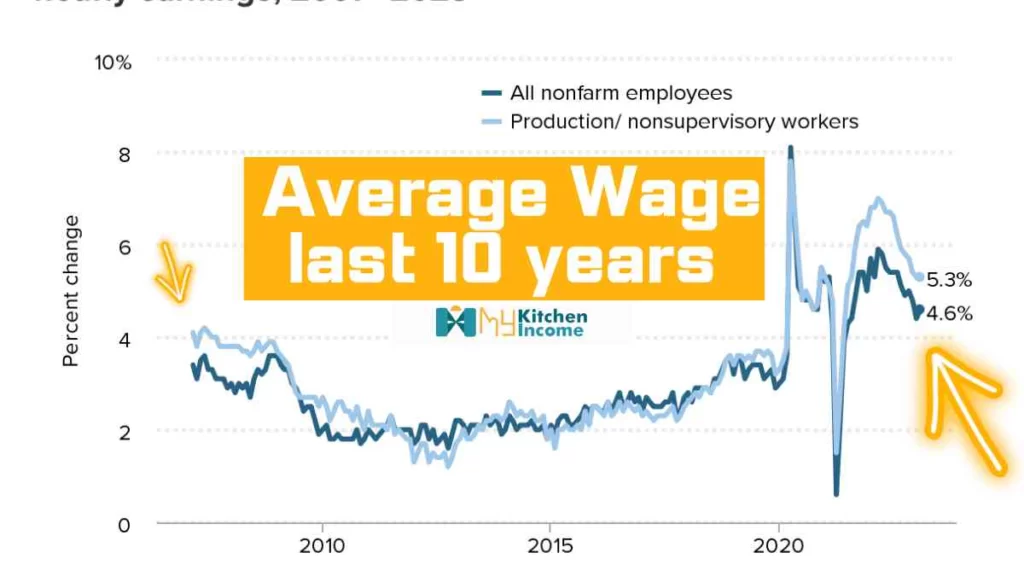I. Introduction
As we progress into the new decade,Average Wage Increase Over 10 Years. It is essential to evaluate the state of the average wage increase over the past 10 years and how it has affected individuals. The average wage increase plays a crucial role in determining the standard of living and financial stability of people, making it a critical topic of discussion. In this article, we will explore how the average wage increase affects individuals, both positively and negatively.
II. Factors Affecting Wage Growth
There are several factors that can affect wage growth over a 10-year period. These include:
Inflation
Inflation is the rate at which prices increase over time. When inflation is high, the cost of living increases, and wages must keep up with the rising prices. If wages do not keep pace with inflation, employees will effectively earn less money over time.
Cost of Living
The cost of living varies by region and can have a significant impact on wages. High-cost areas, such as New York City or San Francisco, often have higher wages to compensate for the high cost of living. However, the cost of living in these areas can also rise quickly, making it difficult for wages to keep up.
Productivity
Productivity refers to the amount of output produced per hour worked. When productivity increases, employers can afford to pay their workers more without raising prices. However, if productivity remains stagnant, wage growth may be limited.
Demand for Labor
The demand for labor is influenced by many factors, including economic growth, industry trends, and technological advances. When demand for labor is high, wages tend to increase as employers compete for qualified workers. However, when demand is low, wages may stagnate or even decrease.
III. Historical Data on Wage Growth
The average wage increase over 10 years varies depending on the time period and industry. According to the Bureau of Labor Statistics (BLS), from 2010 to 2020, the average hourly wage for all workers increased from $19.23 to $27.07, a 41% increase.
However, it’s important to note that this increase is not evenly distributed across all industries and occupations. For example, workers in the healthcare and social assistance industry saw a 49% increase in hourly wages over the same period, while workers in the retail trade industry only saw a 30% increase.
Regional Differences in Wage Growth
There are also significant regional differences in wage growth. For example, from 2010 to 2020, workers in the West saw the highest wage growth at 45%, while workers in the South saw the lowest wage growth at 38%. In addition, metropolitan areas tend to have higher wages than rural areas.
Projected Wage Growth year over year
Looking forward, the BLS projects that wages will continue to increase over the next decade, but at a slower pace than the previous decade. From 2020 to 2030, the BLS projects a 13% increase in average hourly wages for all workers.
However, it’s important to note that projections are subject to change based on economic conditions and other factors. For example, the COVID-19 pandemic has had a significant impact on the economy
IV. Factors Affecting Average Wage Increase
There are various factors that can affect the average wage increase over ten years. Below are some of the most common factors that can impact salary growth:
Industry
The industry that someone works in can have a significant impact on their wage growth over time. Some industries are known for offering higher salaries and more opportunities for growth, while others may have stagnant wages or even declining salaries. For example, technology and healthcare industries have been known to offer higher salaries and faster wage growth over time.
Education and Skills
Education and skills are essential for career advancement and wage growth. People with higher levels of education and more specialized skills tend to earn more money over time than those with lower levels of education or less specialized skills. Additionally, obtaining additional certifications or training in a specific field can also lead to higher salaries and faster wage growth.
Inflation and Cost of Living
Inflation and the cost of living are two critical factors that can impact the wage growth of individuals. If the cost of living increases faster than salaries, individuals may not see any real wage growth. Additionally, inflation can impact salary growth as the value of money decreases over time.
Geographic Location
Where someone lives can also impact their wage growth over time. Different areas of the country may have higher or lower salaries for certain industries or positions. Additionally, the cost of living can vary significantly depending on the location, which can impact wage growth.

V. Strategies for Increasing Average Wage
While some factors that impact average wage increase are out of an individual’s control, there are still strategies they can use to improve their salary growth over time. Below are some of the most effective strategies for increasing average wage:
Negotiation
One of the most straightforward strategies for increasing wage growth is through negotiation. When starting a new job or during performance reviews, individuals can negotiate for higher salaries or bonuses. This can lead to higher initial salaries and faster wage growth over time.
Education and Training
As mentioned previously, education and training can significantly impact wage growth. Investing in additional education or obtaining specialized training can lead to higher salaries and faster wage growth over time.
Career Advancement
Advancing within a company or industry can also lead to higher salaries and faster wage growth. Pursuing leadership roles or management positions can lead to higher salaries and faster wage growth over time.
Geographic Relocation
In some cases, relocating to a new area with a higher cost of living or more significant demand for specific skills can lead to higher salaries and faster wage growth.
Side Hustles or Entrepreneurship
Starting a side hustle or entrepreneurship can also lead to higher salaries and faster wage growth. Individuals can use their skills to start their own businesses or freelance work, allowing them to set their rates and increase their income over time.
VI. The Average Wage Increase Over 10 Years: What Does the Data Say?
According to the Bureau of Labor Statistics (BLS), the average hourly wage for American workers in 2013 was $23.07. Fast forward to 2023, and the average hourly wage has increased to $28.50. This means that the average wage increase over the past ten years has been approximately $5.43 or a 23.5% increase. However, it is essential to note that the average wage increase varies across industries and regions.

VII. How the Average Wage Increase Affects You
The average wage increase can have both positive and negative impacts on individuals. One of the positive effects is that it can improve the standard of living and financial stability of workers. An increase in income means that individuals can afford to pay for their basic necessities, such as food, housing, and healthcare, and have some left over for savings or other expenses. Additionally, a higher income can boost an individual’s self-esteem, leading to improved mental health.
On the other hand, the average wage increase can also have negative consequences, such as inflation. When wages increase, businesses may increase the prices of their goods and services to cover their increased labor costs. This can lead to higher living expenses for individuals, negating the positive effects of the wage increase.
VIII. The Benefits and Drawbacks of the Average Wage Increase
The average wage increase has several benefits, including the ability to improve an individual’s standard of living, financial stability, and mental health. However, it can also lead to inflation and increased living expenses, which can negate the positive effects of the wage increase.
Moreover, the average wage increase can also impact the economy. When wages increase, individuals have more disposable income, leading to increased spending, which can boost economic growth. However, if businesses are unable to cover the increased labor costs, they may have to reduce their workforce or cut back on other expenses, which can negatively affect the economy.
IX. Conclusion
In conclusion, the average wage increase over the past 10 years has been approximately $5.43 or a 23.5% increase. While it can have both positive and negative impacts on individuals, it is important to note that the effects vary across industries and regions. Therefore, it is crucial to evaluate how the average wage increase affects you personally.
X. FAQs
Q: What is the average hourly wage in the United States?
A: According to the Bureau of Labor Statistics, the average hourly wage in the United States in 2023 is $28.50.
Q: What industries have the highest and lowest average wage increases?
A: The industries with the highest average wage increases include healthcare, professional and business services, and transportation and warehousing. The industries with the lowest average wage increases include retail trade, leisure and hospitality, and accommodation and food services.
Q: Can the average wage increase lead to inflation?
A: Yes, when wages increase, businesses may increase the prices of their goods and services to cover their increased labor costs, leading to inflation.
Q: How can I evaluate how the average wage increase affects me personally?
A: The best way to evaluate how the average wage increase affects you personally is to compare your current income to your income from 10 years ago. If your income has increased by more than the average wage increase, you are doing better than the average worker. If your income has increased by less than the average wage increase or has remained stagnant, you may need to evaluate your career path or consider negotiating a higher salary.
Q: What can individuals do to mitigate the negative effects of inflation caused by the average wage increase?
A: To mitigate the negative effects of inflation caused by the average wage increase, individuals can focus on saving money and being mindful of their spending. They can also consider investing in assets that are not affected by inflation, such as stocks or real estate.
Q: Will the average wage increase continue to rise in the future?
A: It is difficult to predict the future of the average wage increase as it varies across industries and regions. However, with the current economic climate and increasing demand for skilled labor, it is possible that the average wage increase will continue to rise in the future.
Q: How can businesses adapt to the average wage increase and its potential impacts on the economy?
A: Businesses can adapt to the average wage increase by focusing on increasing their productivity and efficiency to cover the increased labor costs. They can also consider investing in automation or outsourcing to reduce their labor costs. Additionally, businesses can work with policymakers and industry associations to advocate for policies that support economic growth and stability.


